Is there an Olympic Effect on NHL players?
There’s been much debate about having NHL players participate in the Olympics. Obviously, shutting down the National Hockey League for nearly a month is not good business. Sure, there’s the opportunity to take part in the biggest hockey tournament in the world, but it doesn’t translate directly into a return for the NHL clubs.
But what about the players? Does competing in the Olympics have an impact – good or bad – on players returning to finish the NHL season?
Do the Olympians struggle after a tightly-packed tournament schedule, not to mention the additional travel to and from the games?
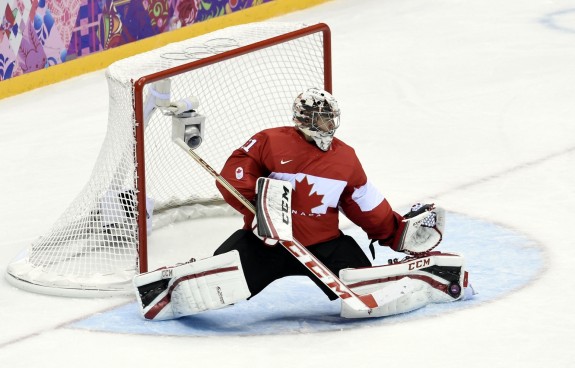
I took a look back at the 2010 Olympics, pulling stats from the ten leading scorers in the Olympics, the top 20 overall NHL scorers, and the top ten non-Olympian scorers. The short list came to 33 players, with some overlap. (Yes, this is an admittedly small sample size, but these are the highest scorers, who would expect to have the most consistent output and whose variation would have the greatest impact on their respective clubs.)
Overall Impact
Of the top ten NHL scorers, only three posted more points-per-game following the Olympics.
Both Olympians and non-Olympians reviewed averaged 0.96 points per game following the Olympic break. For the non-Olympians, it was a slight drop from 0.97. For the Olympic athletes, though, they fell from a pre-tourney average of 1.07 points per game.
| Pre-Olympics | Post-Olympics | |
| Olympians | 1.07 | 0.96 |
| Non-Olympians | 0.97 | 0.96 |
Olympians By Country
| Team | Pre PPG | Post PPG | Change | % Chg |
| CAN | 1.07 | 0.92 | -0.15 | -14.11% |
| FIN | 0.58 | 0.40 | -0.18 | -31.11% |
| RUS | 1.30 | 1.03 | -0.27 | -21.01% |
| SLV | 1.05 | 0.81 | -0.24 | -22.84% |
| SVK | 0.82 | 0.85 | 0.02 | 2.92% |
| SWE | 1.28 | 1.54 | 0.25 | 19.73% |
| USA | 0.91 | 0.95 | 0.04 | 4.30% |
| Total | 1.04 | 0.96 | -0.08 | -7.50% |
By country, the Canadians’ Gold Medal hangover (-14%) and the Russians’ disappointing loss (-21%) had the greatest impact. (Numbers for Finland and Slovenia are discounted due to their small sample size.) The US players were buoyed by consistent scoring before and after, as were the Slovaks.
Team Sweden actually improved after the tournament. Were they responding to an unexpectedly-early elimination, or simply refreshed after having some additional time off?
Let’s take a look at the individual player impacts.
Skaters

Alexander Ovechkin
The Russians were very disappointed in their performance in the 2010 Olympics. While Alexander Ovechkin averaged a point per game in Vancouver, it wasn’t enough to get Team Russia past Canada in the quarterfinals. After four games, his Olympics were over. The Russian superstar took the elimination hard and carried that disappointment back to Washington.
Leading the league in both goals (42) and points (89), Ovechkin was the NHL’s hottest player going into the 2010 Olympic break. He’d cooled considerably on his return. His league-best 1.65 points per game dipped to 1.11 – a 33% drop – as he managed just eight goals over the season’s final 18 games. (Thankfully, his teammates stepped up, as Mike Knuble also netted eight, with all four lines chipping in to keep the Caps atop the East.)
This was way out of character for Ovechkin, who normally finishes strong.
|
Pre-Olympics |
Post-Olympics |
Change |
||||||||||
|
GP |
G |
A |
Pts |
PPG |
GP |
G |
A |
Pts |
PPG |
Change |
% Chg |
|
|
07-08 |
65 |
48 |
35 |
83 |
1.28 |
17 |
17 |
12 |
29 |
1.71 |
0.43 |
33.6% |
|
08-09 |
62 |
46 |
36 |
82 |
1.32 |
17 |
10 |
18 |
28 |
1.65 |
0.32 |
24.5% |
|
09-10 |
54 |
42 |
47 |
89 |
1.65 |
18 |
8 |
12 |
20 |
1.11 |
-0.54 |
-32.6% |
|
10-11 |
62 |
24 |
38 |
62 |
1.00 |
17 |
8 |
15 |
23 |
1.35 |
0.35 |
35.3% |
|
11-12 |
61 |
26 |
23 |
49 |
0.80 |
17 |
12 |
4 |
16 |
0.94 |
0.14 |
17.2% |
|
12-13 |
39 |
25 |
18 |
43 |
1.10 |
9 |
7 |
6 |
13 |
1.44 |
0.34 |
31.0% |
His Olympic year was the only time in the past six seasons where Ovechkin’s points-per-game dropped over the last portion of the season.
This year, the Russians went in with high expectations. With the Olympics on their home turf, they were expected not only to medal, but to bring home the gold. They didn’t make it past the quarterfinals, where they were eliminated by a Finnish team decimated by injuries.
Ovechkin was held scoreless.
“[It’s] tough to explain the loss, of course, why [we] scored so little,” said Russian coach Zinetula Bilyaletdinov. “Players who score so many goals for their clubs, like Alex Ovechkin who scored 40 goals for his club, [didn’t score]… Right now I cannot explain that.”
The disappointment of this loss is far greater than what this club experienced in Vancouver. Will Ovechkin respond? Or will his scoring plummet as it did in 2010?
Henrik and Daniel Sedin

Sweden, like Russia, lost in the 2010 quarterfinals, losing 4-3 to Slovakia and failing to defend their 2006 Gold Medal. Unlike Ovechkin, the Sedins used their Olympic loss as a way to motivate themselves, finding some inspiration in the five days off between Olympic elimination and their return to the NHL.
They came back on fire, with a nine-game point streak (3-14-17) for Daniel and fourteen points for Henrik (3-11-14) over those same nine games. No one scored more post-Olympic points than either of the Sedins, who combined for 17 goals and 46 assists. Henrik rode that wave to the league’s scoring lead, passing Crosby and Ovechkin on his way to claim the Art Ross Trophy.
Sidney Crosby
Crosby was riding high after scoring the golden goal for Team Canada. While nearly all of his Canadian teammates saw their scoring drop, Crosby was reignited. He and the Sedins were the only Olympians among the top 20 scorers who improved on their points-per-game pace post-Olympics. His 1.28 points per game jumped to 1.55 as he posted 31 points over his final 20 games.
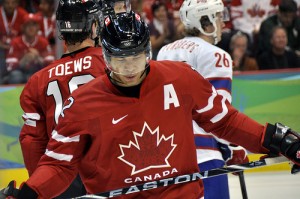
Jarome Iginla
Iginla led all Olympic players with five goals in seven games played. He also assisted on Sidney Crosby’s Golden Goal in overtime.
When he returned to Calgary, he managed just five in the Flames’ remaining 20 games. The Flames were already out of playoff contention at the break, so it’s not exactly like there was much to play for.
The San Jose Sharks’ Top Line
Joe Thornton (1.21 to 0.82), Patrick Marleau (1.03 to 0.95) and Dany Heatley (1.06 to 0.80)
This trio of linemates were all playing well coming into the Olympics. After bringing home the gold in 2010, they came crashing down to earth. Whether they were physically exhausted or just emotionally spent, they couldn’t keep up their pre-Olympic pace. All saw their points-per-game drop, with Thornton taking the biggest hit, scoring 33% less.
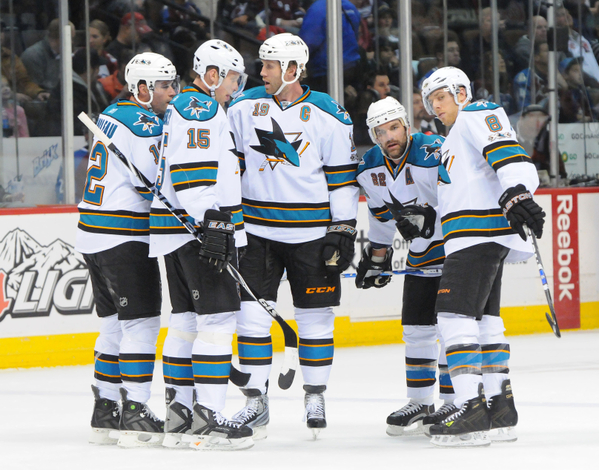
Goaltenders
The Top 5 Olympic goaltenders in Vancouver came back, on average, to lower save percentages and higher goals-against averages.
| Save Percentage | Goals Against Average | ||||||||
| Pre | Post | Chg | % Chg | Pre | Post | Chg | % Chg | ||
| Miller (USA) |
0.930 | 0.922 | -0.008 | -0.90% | 2.13 | 2.29 | 0.16 | 7.50% | |
| Bryzgalov (RUS) |
0.920 | 0.923 | 0.003 | 0.30% | 2.30 | 2.27 | -0.04 | -1.50% | |
| Vokoun (CZE) |
0.931 | 0.896 | -0.035 | -3.80% | 2.38 | 3.17 | 0.79 | 33.10% | |
| Lundqvist (SWE) |
0.920 | 0.924 | 0.004 | 0.40% | 2.31 | 2.21 | -0.1 | -4.50% | |
| Luongo (CAN) |
0.919 | 0.893 | -0.027 | -2.90% | 2.25 | 3.13 | 0.88 | 38.90% | |
Ilya Bryzgalov and Henrik Lundqvist returned with slightly higher stats in 2010. Their teams, Russia and Sweden, respectively, were both eliminated in the quarterfinals. The goaltenders each had nearly a week off – certainly the longest stretch of the season either of these workhorses went without playing – which helped out for the late-season push. Team USA’s Ryan Miller saw his numbers slip just slightly in the opposite direction. The big changes came from Tomas Vokoun and gold-medal-winning Canadian netminder Roberto Luongo.
Vokoun’s save percentage plummeted from pre-Olympic .931 to a pedestrian .896 while his goals-against soared from 2.38 to 3.17 per game. While the increased Olympic workload and failure to medal may have contributed, a bigger factor was the team to which he returned. The Panthers were well out of playoff contention. It’s hard to be motivated when your season’s already over.
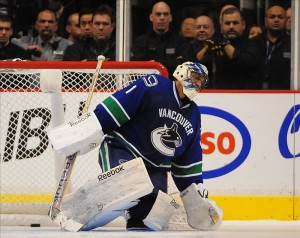
The biggest surprise came from Roberto Luongo. While the Vancouver Canucks were able to cruise to another Pacific Division title, they did so more on the strength of their offense than on Luongo’s work in the crease. After the Olympic break, his .919 save dropped to .893, while his GAA skyrocketed from 2.25 to 3.13. He’d allowed more than three goals just six times over his first 52 games; over his last 16 starts, it happened five times. If it weren’t for the Sedins’ red-hot scoring run, the Canucks would’ve had a tough battle to end the year atop the Pacific.
Luongo’s not the first goaltender to suffer an Olympic gold medal hangover.
In 2006, the Rangers’ Henrik Lundqvist led Sweden to Olympic gold. While his drop-off wasn’t as dramatic as Luongo’s, he still posted a lower save percentage (.927 to .907) and higher goals-against (2.16 to 2.62). It might not look like much, but it was enough to cause the Rangers to fall down the standings. Leading the Atlantic Division going into the Olympics, the club finished behind the Flyers and Devils, ending up sixth in the Conference.
| Lundqvist – Save Percentage | Lundqvist – Goals Against Average | |||||||||
| Pre | Post | Chg | % Chg | Pre | Post | Chg | % Chg | |||
| 05-06 | 0.927 | 0.907 | -0.02 | -2.20% | 05-06 | 2.16 | 2.62 | 0.46 | 21.30% | |
| 06-07 | 0.909 | 0.94 | 0.031 | 3.40% | 06-07 | 2.47 | 1.71 | -0.76 | -30.80% | |
| 07-08 | 0.909 | 0.923 | 0.014 | 1.50% | 07-08 | 2.33 | 1.88 | -0.45 | -19.30% | |
| 08-09 | 0.913 | 0.926 | 0.013 | 1.40% | 08-09 | 2.49 | 2.12 | -0.37 | -14.90% | |
| 09-10 | 0.92 | 0.924 | 0.004 | 0.40% | 09-10 | 2.34 | 2.12 | -0.22 | -9.40% | |
| 10-11 | 0.921 | 0.927 | 0.006 | 0.70% | 10-11 | 2.29 | 2.06 | -0.23 | -10.00% | |
(*Non-Olympic years use the last 17 games of the season for calculation purposes as ‘post-break comparable’)
While it’s not a significant change, you can see that Lundqvist’s finishes were stronger in his non-Olympic years.
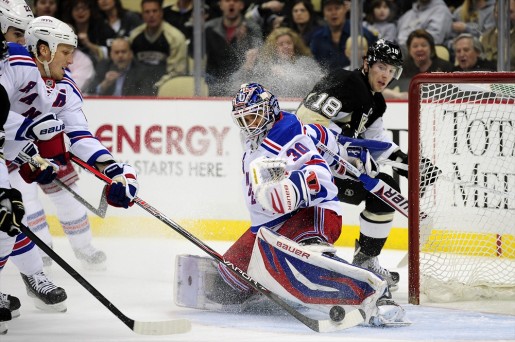
Luongo also tends to close out the season strong. His 2009 save percentage improved from .917 to .924 over the last 17 games, while his goals-against trimmed down from 2.35 to 2.18. He saw even more improvement in 2011, when he allowed just 1.76 goals per game over the last fifth of the season. That Olympic Gold Medal year, though, saw his performance slip.
| Luongo – Save Percentage | Luongo – Goals Against Average | |||||||||
| Pre | Post | Chg | % Chg | Pre | Post | Chg | % Chg | |||
| 08-09 | 0.917 | 0.924 | 0.007 | 0.80% | 08-09 | 2.35 | 2.18 | -0.17 | -7.20% | |
| 09-10 | 0.928 | 0.902 | -0.026 | -2.80% | 09-10 | 2.25 | 2.83 | 0.58 | 25.80% | |
| 10-11 | 0.926 | 0.934 | 0.008 | 0.90% | 10-11 | 2.23 | 1.76 | -0.47 | -21.10% | |
Will the Sochi netminders – especially the gold-medal winner – again feel the effects of the midseason tournament as they push for the playoffs?
Teams
Out West, the Sharks and Ducks both had the most Olympians, with eight each. While the Ducks stayed flat, the Sharks dropped.
Five of their eight Olympians were in the gold medal game which likely wore on them. Coming back from the break, they scored less and allowed more. The Sharks saw three players return to lower stats despite winning gold in Vancouver in Thornton, Heatley, and Marleau.
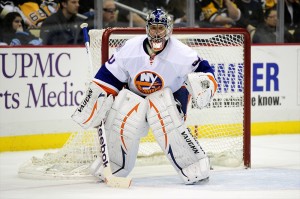
Goaltender Evgeni Nabokov was affected by the Russian team’s disappointing performance, as well as his own. The netminder posted a 4.17 GAA and a .853 save percentage in three games at the 2010 Olympics. His post-Olympic numbers (.902 sv, 2.83 GAA) were off from his pre-tournament performance (.928 sv., 2.25 GAA).
For the most part, diversity in representation balanced out the team impacts. With nearly all teams represented at the Olympics, they all felt some sort of impact – some good, others bad. None so significant to eliminate them from playoff contention.
As far as a team-wide Olympic effect, it appears that the culturally-balanced NHL rosters do a good job of offsetting some of the individual impacts.
Gold Medalists and Disappointments
The Olympics take their toll on players, physically and mentally. The ones who seemed most affected were those who had a disappointing tournament – in Vancouver, the Russians – or the Canadians who brought home the gold. After reaching such an emotional high, especially in your home country, it can only be somewhat of a letdown to return to your ‘day job’ in the NHL.
What will the 2014 Sochi games bring? Will another devastating disappointment follow Ovechkin and his countrymen back to the NHL? Will a surprise Olympic run by Slovenia give Kings forward Anze Kopitar a late-season boost? Will the gold-medal winning netminder be able to hang on through his Olympic hangover?
We’ll have to wait and see. Just don’t be surprised when it happens.
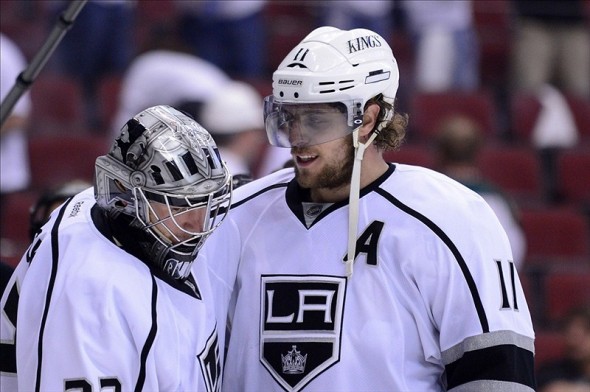
Follow Josh on Twitter – @joshsmith29
Stats/Reference:
2010 scoring totals, pre- and post-Olympics, sorted by regular season total:
|
PRE |
POST |
||||||||||||
| Team | Player |
GP |
G |
A |
Pts |
P/gm |
GP |
G |
A |
Pts |
P/gm |
Change |
% Chg |
| SWE | Henrik Sedin |
61 |
25 |
55 |
80 |
1.31 |
21 |
4 |
28 |
32 |
1.52 |
0.21 |
16% |
| CAN | Sidney Crosby |
61 |
42 |
36 |
78 |
1.28 |
20 |
9 |
22 |
31 |
1.55 |
0.27 |
21% |
| RUS | Alexander Ovechkin |
54 |
42 |
47 |
89 |
1.65 |
18 |
8 |
12 |
20 |
1.11 |
-0.54 |
-33% |
| Non-Olympic | Niklas Backstrom |
62 |
26 |
50 |
76 |
1.23 |
20 |
7 |
18 |
25 |
1.25 |
0.02 |
2% |
| Non-Olympic | Steven Stamkos |
61 |
35 |
35 |
70 |
1.15 |
21 |
16 |
9 |
25 |
1.19 |
0.04 |
4% |
| Non-Olympic | Martin St. Louis |
61 |
22 |
49 |
71 |
1.16 |
21 |
7 |
16 |
23 |
1.10 |
-0.07 |
-6% |
| Non-Olympic | Brad Richards |
59 |
17 |
49 |
66 |
1.12 |
21 |
7 |
18 |
25 |
1.19 |
0.07 |
6% |
| CAN | Joe Thornton |
62 |
16 |
59 |
75 |
1.21 |
17 |
4 |
10 |
14 |
0.82 |
-0.39 |
-32% |
| USA | Patrick Kane |
61 |
25 |
42 |
67 |
1.10 |
21 |
5 |
16 |
21 |
1.00 |
-0.10 |
-9% |
| SVK | Marian Gaborik |
58 |
35 |
34 |
69 |
1.19 |
18 |
7 |
10 |
17 |
0.94 |
-0.25 |
-21% |
| RUS | Ilya Kovalchuk |
55 |
32 |
31 |
63 |
1.15 |
21 |
9 |
13 |
22 |
1.05 |
-0.10 |
-9% |
| SWE | Daniel Sedin |
43 |
16 |
38 |
54 |
1.26 |
20 |
13 |
18 |
31 |
1.55 |
0.29 |
23% |
| RUS | Alex Semin |
53 |
30 |
35 |
65 |
1.23 |
20 |
10 |
9 |
19 |
0.95 |
-0.28 |
-23% |
| CAN | Patrick Marleau |
62 |
38 |
26 |
64 |
1.03 |
20 |
6 |
13 |
19 |
0.95 |
-0.08 |
-8% |
| USA | Zach Parise |
60 |
28 |
33 |
61 |
1.02 |
21 |
10 |
11 |
21 |
1.00 |
-0.02 |
-2% |
| CAN | Dany Heatley |
62 |
32 |
34 |
66 |
1.06 |
20 |
7 |
9 |
16 |
0.80 |
-0.26 |
-25% |
| SLV | Anze Kopitar |
61 |
28 |
36 |
64 |
1.05 |
21 |
6 |
11 |
17 |
0.81 |
-0.24 |
-23% |
| USA | Paul Stastny |
61 |
12 |
42 |
54 |
0.89 |
20 |
8 |
17 |
25 |
1.25 |
0.36 |
41% |
| RUS | Evgeni Malkin |
55 |
21 |
44 |
65 |
1.18 |
12 |
7 |
5 |
12 |
1.00 |
-0.18 |
-15% |
| USA | Mike Green |
57 |
14 |
46 |
60 |
1.05 |
18 |
5 |
11 |
16 |
0.89 |
-0.16 |
-16% |
| Non-Olympic | Vincent Lecavalier |
61 |
15 |
40 |
55 |
0.90 |
21 |
9 |
6 |
15 |
0.71 |
-0.19 |
-21% |
| CAN | Jarome Iginla |
62 |
27 |
30 |
57 |
0.92 |
20 |
5 |
7 |
12 |
0.60 |
-0.32 |
-35% |
| CAN | Ryan Getzlaf |
56 |
17 |
44 |
61 |
1.09 |
10 |
2 |
6 |
8 |
0.80 |
-0.29 |
-27% |
| Non-Olympic | Derek Roy |
58 |
16 |
27 |
43 |
0.74 |
22 |
10 |
16 |
26 |
1.18 |
0.44 |
59% |
| CAN | Jonathan Toews |
55 |
19 |
30 |
49 |
0.89 |
21 |
6 |
13 |
19 |
0.90 |
0.01 |
2% |
| Non-Olympic | Nik Antropov |
56 |
15 |
35 |
50 |
0.89 |
20 |
9 |
8 |
17 |
0.85 |
-0.04 |
-5% |
| Non-Olympic | Travis Zajac |
61 |
19 |
32 |
51 |
0.84 |
21 |
6 |
10 |
16 |
0.76 |
-0.07 |
-9% |
| Non-Olympic | Alex Burrows |
61 |
26 |
25 |
51 |
0.84 |
21 |
9 |
6 |
15 |
0.71 |
-0.12 |
-15% |
| Non-Olympic | Patrick Sharp |
61 |
19 |
33 |
52 |
0.85 |
21 |
6 |
8 |
14 |
0.67 |
-0.19 |
-22% |
| SVK | Marián Hossa |
37 |
17 |
17 |
34 |
0.92 |
20 |
7 |
10 |
17 |
0.85 |
-0.07 |
-8% |
| FIN | Niklas Hagman |
62 |
21 |
15 |
36 |
0.58 |
20 |
4 |
4 |
8 |
0.40 |
-0.18 |
-31% |
| USA | Brian Rafalski |
57 |
4 |
25 |
29 |
0.51 |
21 |
4 |
9 |
13 |
0.62 |
0.11 |
22% |
| SVK | Pavol Demitra |
11 |
1 |
3 |
4 |
0.36 |
16 |
2 |
10 |
12 |
0.75 |
0.39 |
106% |
Oh great so now it’s bad that King Henrik gets to play for a gold medal?
Josh – fantastic article! It’s something that many people forget when they’re happy to have their players on the national teams. It can be long. It can be gruelling and it can take a lot out of their players.
Glad you took a look at this and developed such a wonderfully put together piece.